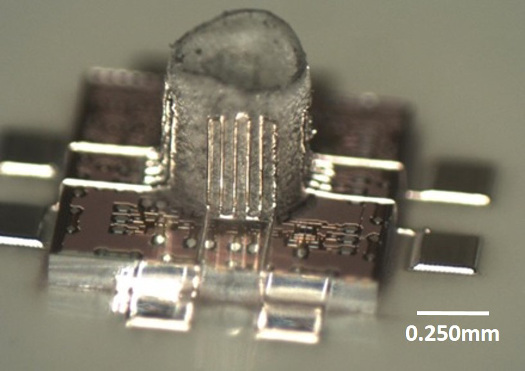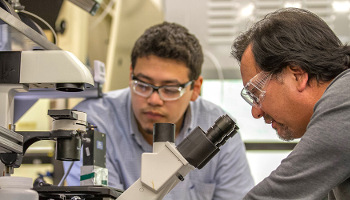 |
| August 23, 2016 | Volume 12 Issue 32 |
Designfax weekly eMagazine
Archives
Partners
Manufacturing Center
Product Spotlight
Modern Applications News
Metalworking Ideas For
Today's Job Shops
Tooling and Production
Strategies for large
metalworking plants
Engineer's Toolbox:
Electronics 3D printer achieves mind-blowing micron details
Installation of a highly advanced 3D printer for electronics at Lawrence Livermore National Laboratory (LLNL) has opened the door for creating miniature circuits on surfaces and substances that could never be used before.
The Optomec Aerosol Jet 5X system, which became operational in January, is capable of printing circuits with a broad range of nanomaterials, allowing engineers to manufacture conductors, semiconductors, and microcircuits with an intricacy and flexibility not possible with the lab's previous technology. LLNL is an early adopter of the Aerosol Jet 500 version of the machine.

Aerosol Jet 3D-printed micro-structure showing a freestanding, millimeter-wave dipole antenna. [Photo: Optomec]
The Aerosol Jet process uses aerodynamic focusing to precisely and accurately deposit atomized electronic inks onto substrates.
"To be able to print electronic components in 3D is a fundamental game changer," says Chris Bishop, electronics managing supervisor in LLNL's Materials Engineering Division (MED). "The hard part is figuring out what to focus on first."
This new capability is enabled by combining Optomec's proven Aerosol Jet solution for fine-feature printing with a proprietary in-situ curing capability for rapid on-the-fly solidification. Unlike other high-resolution 3D-printing approaches that deposit material globally (i.e., in a powder bed) and then cure locally to define a pattern, the Optomec method relies on both local deposition and local curing. This makes the process more economical, in terms of material consumption, but it is also key to enabling the highest resolution features available.

Lawrence Livermore electronics technologists Dale Kurita, at microscope, and Julian Larregui examine manufacturing circuits for 3D printing. [Photo by Julie Russell/LLNL]
Perhaps equally important, the 260-sq-ft Optomec system can potentially replace an entire 2,700 sq-ft electronics prototyping facility, which required a high volume of hazardous chemicals to operate.
"We're in the process of moving toward a safer environment," Bishop says. "It's really cool to say we've eliminated the hazard and have the same capability, but to have more capability in less space, it's huge."
Previously, the smallest components created in the facility were limited to 50 to 100 microns. The Optomec machine can print at 10 microns and also is not limited to copper or metallic inks. It's capable of utilizing a number of conductive and nonmetallic materials, even proteins, and printing on surfaces such as glass, plastic, or kapton, a thin heat-resistant polymer. It also can print at any angle in three dimensions, meaning engineers can experiment with 3D-printed antennas, flexible circuits, components for robots, and pressure and medical sensors.
"When we use it, we can print at different angles and conform it the way we want," says Dale Kurita, a senior electronics technologist. "There's just unlimited capabilities in the future. This opens up a whole new door for people to look at electronics differently."
Electronics technologist Julian Larregui, who is figuring out how to use the software, says he was amazed by the printer's potential.
"I can make electronics that are not only flat, but curved," Larregui says. "My mind was kind of blown. At first it was intimidating, but now that I've done it a few times, I'm much more confident."
VIDEO: The Aerosol Jet 5X System is a 5-axis platform enabling users to print functional electronics on virtually any substrate. The system is designed for the development and production of smart devices for consumer electronics, automotive, aerospace, health care, and Internet of Things applications where smaller, lighter, and intelligent devices are required.
LLNL MED engineers are experimenting with the machine using silver nanoparticles and will be moving toward other conductive inks in the future. They also plan to expand to different substrates and inks such as platinum, aluminum, and copper.
Circuit board manufacturers and companies in the medical, weapons, and aerospace industries have already shown interest in what can be done with the printer, Bishop says.
"There's a lot of people excited about this," Bishop says. "It's only a matter of time."
Using this system to its fullest, free-form 3D structures can be printed at the micron scale, without the need for support structures, from materials that also include photopolymers and certain composites. Additionally, the resulting structures can be metallized with conformal 3D conductive traces and printed functional components, such as antennas and sensors, to create fully functional 3D components -- all in one manufacturing machine. This direct digital approach optimizes the fabrication process while reducing manufacturing steps and material usage along the way, making Aerosol Jet 3D micro-structure printing a cost-effective, green technology.
Click here to access a white paper on Aerosol Jet 3D micro-structure printing.
The Laboratory Directed Research and Development program funded the procurement of the Optomec system.
Sources: Compiled from Lawrence Livermore National Laboratory and Optomec reports
Published August 2016
Rate this article
View our terms of use and privacy policy
